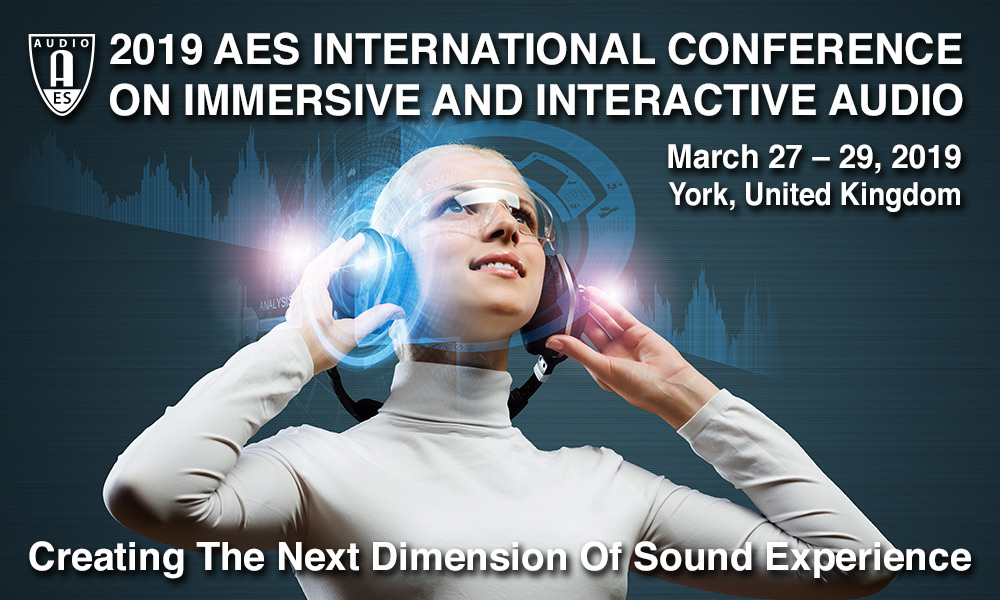| Home | Call for Contributions | Program | Registration | Venue & Facilities | Accessibility & Inclusivity | Travel | Sponsors | Committee | Twitter |

Chair: Chris Pike
Ambisonics is a spatial audio rendering method appropriate for dynamic binaural synthesis due to its sound field rotation and transformation capabilities. An issue of low-order Ambisonics is that interaural level differences (ILDs), a crucial cue for lateral localisation, are often reproduced lower than they should be, which reduces lateral localisation accuracy. This paper introduces a method for Ambisonic ILD Optimisation (AIO), aiming to bring the ILDs produced by binaural Ambisonic rendering closer to those of head-related impulse responses (HRIRs). AIO is evaluated versus a reference dataset of HRIRs for all locations on the sphere using estimated ILD, perceptual spectral difference and horizontal plane localisation. Results show an overall improvement in all tested metrics.
http://www.aes.org/e-lib/browse.cfm?elib=20421
Ambisonics has been widely adopted for conveying immersive audio experiences via headphone based sound scene reproduction. It is well known, however, that order limitation causes blurred source images, reduced spaciousness and direction dependent timbral artifacts when rendered for binaural playback. Signal-dependent methods aim to remedy these shortcomings based on a set of estimated sound field parameters or by injecting decorrelated signals, however, parameter estimation errors and decorrelator artifacts oftentimes introduce audible artifacts. In this work we propose a signal-dependent method for binaural redering of Ambisonic signals based on a constrained least-squares decoder. The method enables faithfull reproduction of a direct and a diffuse signal per time-frequency tile requiring only a single parameter and without the need of injecting decorrelated signals.
http://www.aes.org/e-lib/browse.cfm?elib=20422
This demo paper aims at introducing a novel VST binaural audio plugin based on the 3D Tune-In (3DTI) Toolkit, a multiplatform open-source C++ library which includes several functionalities for headphone-based sound spatialisation, together with generalised hearing aid and hearing loss simulators. The VST plugin integrates all the binaural spatialisation functionalities of the 3DTI Toolkit for one single audio source. The spatialisation is based on direct convolution with any user-imported Head Related Transfer Function (HRTF) set. Interaural Time Differences (ITDs) are customised in real-time according to the listener’s head circumference. Binaural reverberation is performed using a virtual-loudspeakers Ambisonic approach and convolution with user-imported Binaural Room Impulse Responses (BRIRs). Additional processes for near- and far-field sound sources simulations are also included.
http://www.aes.org/e-lib/browse.cfm?elib=20423
This paper presents a theoretical, analytical and experimental studies for synthesizing virtual auditory space to multiple listeners using binaural synthesis over two-channel loudspeakers. The optimal source distribution (OPSODIS) improves many of the problems arising with the binaural reproduction over loudspeakers. The principle utilizes the idea of a pair of conceptual monopole transducers whose azimuthal location varies continuously as a function of frequency. In this paper, theoretical considerations under free-field conditions and numerical calculations including the effect of head related transfer functions for off-axis listeners are presented. It is revealed that the OPSODIS can also provide the same binaural signals as for the on-axis target listener to the ears of multiple off-axis listeners.
http://www.aes.org/e-lib/browse.cfm?elib=20424
